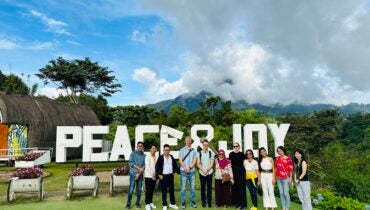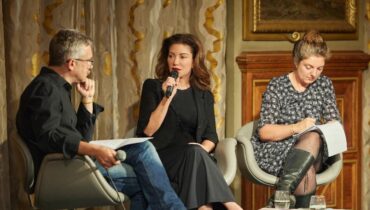Women’s leadership in the development and implementation of innovative approaches to building peace is integral to engaging with the greater field of peace and security. Just as peace processes benefit from women delegates – and transitional justice from women judges and advocates – so too does the creative development of new fields benefit from women theoreticians and practitioners. Nowhere is this more evident than in the small, but promising field of Peace through Health. As the field has grown, two women have figured prominently in articulating the theoretical development of the field and demonstrating examples of its effective implementation. Looking to the work of Dr. Joanna Santa Barbara and Dr. Paula Gutlove, it is evident that their leading roles have been an invaluable contribution to the development of a new and innovative approach to building peace.
What is Peace through Health?
Peace through Health is an approach to peacebuilding that utilizes the unique access and position of health care professionals to positively impact conflict. It is based on the recognition that health and conflict are intimately related, and that health care professionals are often accorded access to denied areas/populations, held in high social esteem, and practice a profession defined – at least in part – by altruistic principals. Peace through Health seeks to take advantage of these characteristics through using health programming and professionals to promote opportunities for dialogue, address issues of structural conflict, and facilitate personal and communal healing in post-conflict settings.
The first examples of Peace through Health efforts were undertaken by the Pan American Health Organization (PAHO) in the early 1980’s to address conflict between guerilla groups and the government in El Salvador and Peru. Using mutual concern over children’s health, PAHO implemented a campaign of “days of tranquility” or temporary cease-fires in order to immunize children from both groups against preventable disease. Through temporary ceasefires that continually grew in length, space and time were created to bring opposing groups to the table, eventually leading to a political resolution of the armed conflict. The idea of using immunization campaigns as a way to temporarily halt hostilities, while at the same time providing for the basic health needs of their respective populations, soon took hold. Primarily through the work of the WHO, similar campaigns were introduced throughout the late 1980’s and 1990’s in countries such as Afghanistan, Lebanon, Somalia, and Sri Lanka among others. As these efforts grew, so too did similar programming using trauma recovery and psychosocial interventions as a means to heal from conflict and prevent its resumption.
Influential Women Leaders
Though work had begun to be done pairing health and conflict programming, there was little theoretical or academic support for such efforts until the late 1990’s. When individuals in the academic community finally began discussing these joint efforts, the voice of Dr. Joanna Santa Barbara was consistently at the front of the field. Through her association with the Center for Peace Studies at McMaster University, as well as her many publications, she advocated for the growth of Peace through Health as a field. During her time at McMaster, the university established the Peace through Health Initiative and led the academic world in the development of Peace through Health. The university convened the first academic conference related to the field in 2001, soon followed by a second in 2005. Throughout this entire process, Dr. Santa Barbara, in partnership with Dr. Graeme MacQueen, also established the first university course in Peace through Health. And in 2008, she co-edited the first comprehensive book on the field, Peace through Health: How Health Professionals Can Work for a Less Violent World, in collaboration with Dr. Akshaya Neil Arya.
In addition to leading the academic development of the field, she was influential in articulating the principals upon which a solid theory defining the new field could grow. Through her articles co-authored with Dr. MacQueen, she articulated ten guiding mechanisms that continue to underlie the theoretical explanations of why Peace through Health can be an effective way of promoting peace. Additionally, she helped formulate the theoretical stages of involvement of health care professionals with conflict in a manner consistent with traditional conflict resolution theory.
At the same time that Dr. Santa Barbara was playing an influential role in the academic and theoretical development of Peace through Health, Dr. Paula Gutlove was at the forefront of implementing Peace through Health programming. A dentist by training, Dr. Gutlove founded the Health Bridges for Peace project at the Institute for Resource and Security Studies (IRSS) in 1996. As the project director Dr. Gutlove utilized her training in negotiation, facilitation, and conflict resolution to implement programming that integrated the delivery of health care with conflict management and sustainable community reconciliation.
Throughout the late 1990’s and early 2000’s, Dr. Gutlove facilitated the development of medical networks in the former Yugoslavia and North Caucasus. These medical networks used the shared concern for public health as a way to bring health care professionals from conflicting ethnic and religious groups together. Once convened, the meetings were designed to provide training in negotiation and conflict resolution skills, brainstorm the development on locally implementable psychosocial healing programs, and provide a safe space in which individuals from different groups could interact and share information. In addition to her work in developing medical networks, Dr. Gutlove has also been consistently involved in the U.S.-Muslim Engagement Initiative, again using a shared interest in public health as a way to promote dialogue and negotiation. With her efforts over the last decade and a half, Dr. Gutlove has been a consistent and tireless practitioner using health as a vehicle for peace. Her work has done much to promote peace, and demonstrate the practical applicability of the theory Dr. Santa Barbara helped articulate.
Conclusion
The theoretical development of new and innovative ways to build peace plays an integral role in the growth of the field of peace and security. Without envisioning new paths to address issues of conflict and security, or the creative combination of existing efforts, potential gains are lost. The pioneering work of Dr. Santa Barbara and Dr. Gutlove provides a tangible demonstration of the valuable role women can and should play in this creative work. While the field of Peace through Health still has a long way to mature – and women will most certainly continue to play a leading role in its development – it’s growth to date constitutes a strong example of the way in which peace, conflict, and security has benefited from women’s leadership.

